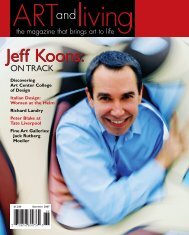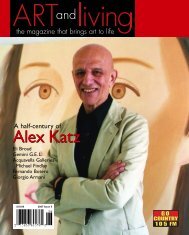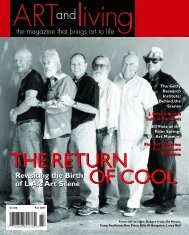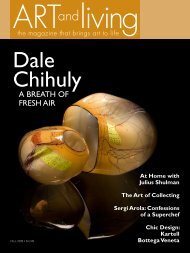Ed Ruscha Ed Ruscha Ed Ruscha - Art and Living
Ed Ruscha Ed Ruscha Ed Ruscha - Art and Living
Ed Ruscha Ed Ruscha Ed Ruscha - Art and Living
- No tags were found...
Create successful ePaper yourself
Turn your PDF publications into a flip-book with our unique Google optimized e-Paper software.
The alarm clock had sounded resoundingly <strong>and</strong> the unorthodox spirit of hisgallery reverberated with his clientele. Goulds confesses, “I took my first salarycheck in 1981.” As to whether he used it to buy art, Goulds laughs, “I bought ahouse. I already had far too much art at that stage—it would take me the rest ofmy life to sell it all.”La Mère Sur La MerWith emerging artists Gajin Fujita <strong>and</strong> Rebecca Campbell; the identifiable work ofDeborah Butterfield,Tony Berlant,Nancy Reddin Kienholz;Tom Wudl,Gwynn Murrill,DonSuggs, Peter Shelton, Joel Shapiro <strong>and</strong> Frederick Hammersley; the estates of Fred Williams<strong>and</strong> <strong>Ed</strong>ward Kienholz; <strong>and</strong> providing a Los Angeles home to an international surge that,in addition to David Hockney, comprises Sean Scully, Richard Deacon, Per Kirkeby, LeonKossoff,Tony Bevan, Guillermo Kuitca, Juan Uslé <strong>and</strong> Domenico Bianchi, Goulds ensuresthat the gallery consistently delivers on the intent he set out with in 1975.Additionally, Goulds <strong>and</strong> the gallery’s preparator for the past sixteen years, artist<strong>and</strong> independent curator Chris Pate, scour Los Angeles’ artists to uncover hidden treasuresfor LA Louver’s Rogue Wave as a “way of making a contribution, in hopefully agood curatorial rigorous way, to the changing tapestry of emerging artists,” says Goulds.The third installment of Rogue Wave will whet exploratory artistic appetites in 2007.“If there’s a unifying force between all the disparate artists I work with internationally,nationally, locally…it’s the intellectual rigor in the studio, how it is theycome to what it is they have the need to make,” explains Goulds. “The image isone thing but what is it that brought that image into life? That’s what I look for—an intellectual curiosity.That’s what turns me on <strong>and</strong> provides me with the incentiveto work hard on their behalf.”La PèreThirty years on, Goulds takes stock of the progress of his assignment. “Obviously,I’ve stayed connected <strong>and</strong> engaged with my only subject,” he says.“I’m very proud of the fact that very little of our work comes up for resalewhen you consider how much art we’ve sold over the years,” he continues. “It’simmense. The people that buy the art want to own it. They’re not speculating,they’re not in this for some dice throw…they’re hopefully using their discretionaryincome to enhance their lives. I believe that art should be bought with discretionaryincome, not as an investment, <strong>and</strong> it should hopefully enrich the experienceof the viewer. We attract, hopefully, the same kind of independent maverick spiritin the buyers as is imbued in the artists we represent.”Indeed, the modern explorer is one who delivers packaged experiences to us,brings boundaries <strong>and</strong> borders within our midst <strong>and</strong> confronts us with reflectionsof our world <strong>and</strong> ourselves. It’s no coincidence then that Goulds, the ManchesterSchool of <strong>Art</strong> graduate who came to UCLA as a visiting lecturer in 1972, hasenlightened the well-traveled with a serious appreciation of the artistic l<strong>and</strong>scapeof coastal California <strong>and</strong> contemporaneously enabled Angeleno canal-dwellers totraverse the globe through the gallery’s gatherings.A portrait of Goulds by Hockney recently came down at LACMA to makeway for a Belgian surrealist who might have declared that Peter Goulds, well, “iln’est pas un march<strong>and</strong> d’art.” But it is that other friend of André Breton, MarcelDuchamp, without whom LA Louver may have been dubbed simply “Venice <strong>Art</strong>Gallery”, who aptly stated,“The individual, man as a man, man as a brain, if you like,interests me more than what he makes…”Goulds’s distinct gift is his ability to see not what is created, but to questionwhy. It is in pursuit of that unanswerable but gripping quest that LA Louvermakes her mark.A ROSE BY ANY OTHER NAMEPETER GOULDS ON “LA LOUVER”In 1920, Marcel Duchamp made a miniature French window <strong>and</strong> calledit Fresh Widow—bad pun, right? It was made by a French window maker,sits on a baseboard, <strong>and</strong> has panes of leather rather than glass.The actof cleaning the window is actually one of polishing, so it shines.In my apartment at UCLA every single window was a louvered window<strong>and</strong>, coming from Engl<strong>and</strong> as I do, I’d never seen a louvered windowin my life.They have them, of course—I’d just never seen one. If you lookat the device that opens the window, it looks like the coffee grinder inDuchamp’s The Bride Stripped Bare by Her Bachelors.In 1931, André Breton (the surrealist poet <strong>and</strong> critic) wrote an articlecalled “The Lighthouse of the Bride”. Evidently (from the article) Duchamphad given Breton his notes of the making of <strong>and</strong> thinking behind The BrideStripped Bare by Her Bachelors <strong>and</strong> Breton took these notes <strong>and</strong> cipheredthe painting. Duchamp had previously given no information of what thepainting was about, gives this critic his notes for the first time, <strong>and</strong> this manreads all the notes diligently <strong>and</strong> writes an essay about the true meaning ofthe painting. The first paragraph says—<strong>and</strong> I’m paraphrasing—thatDuchamp invites us on a journey through the artistic looking glass <strong>and</strong> hegoes on to explicate the meaning of the painting.So my miniature Los Angeles window doesn’t have leather <strong>and</strong>doesn’t have glass but it has mirrors. So, when it’s closed you see yourown reflection but when you ratchet the coffee grinder—via the reflectionof the outside world in the mirrors—you journey through the artisticlooking glass.Duchamp’s baseboard reads (<strong>and</strong> it’s the first time he used his femalepseudonym), “Fresh Widow, 1920, Rose Sélavy.” My baseboard now reads,“La Louver, 1976, Eros it is the mirror.”When I opened the gallery my ego was such that I wouldn’t put myname on something that might fail. So, I needed a pseudonym. My wife said,“Why don’t you call it that wretched LA Louver?” It was one of the manyprops I had made for film projects that were littering the house at the time,<strong>and</strong> I thought that was a good idea..Now we’re stuck with it.<strong>Art</strong> <strong>and</strong> <strong>Living</strong> 47






